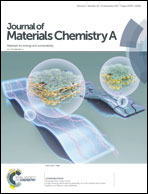Three electron channels toward two types of active sites in MoS2@Pt nanosheets for hydrogen evolution†
Abstract
Molybdenum disulfide (MoS2) has emerged as a promising electrocatalyst for the hydrogen evolution reaction (HER), but its activity generally suffers from limited edge active sites and stagnant conductivity. Here we report a controllable Pt decoration strategy on MoS2 nanosheet arrays (NSAs) anchored on three-dimensional (3D) conductive carbon fiber cloth (CFC) substrates to boost the electrocatalytic HER activity to an upper level comparable to commercial Pt foil catalysts in acidic media, with a low overpotential of −70 mV and a Tafel slope of 36 mV per decade as well as a large exchange current density of 0.43 mA cm−2. The results show that laden Pt makes the inert basal surface of MoS2 an attractive platform steering three electron channels toward two types of active sites, that is, electron transfer from CFC to MoS2 edge sites and surface Pt sites, as well as photo-excited electron injection from MoS2 domains to adjacent Pt sites, promising an excellent HER performance. This study presents a feasible approach to boost the HER activity of MoS2 through surface decoration activating the inert basal surface and provides deep insights for designing MoS2-based HER catalysts.



 Please wait while we load your content...
Please wait while we load your content...